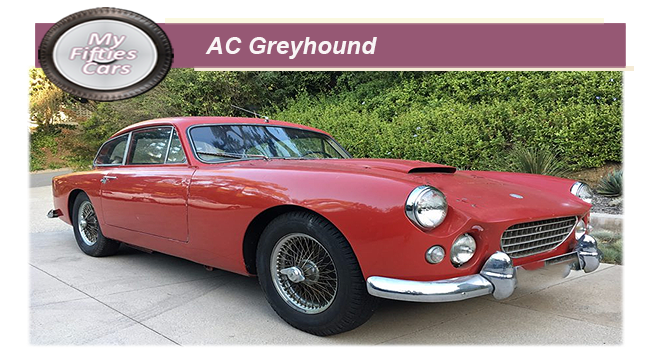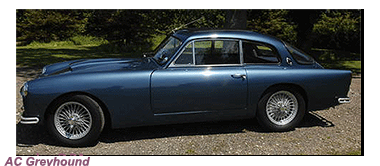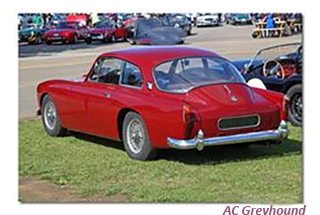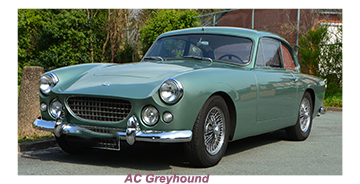
Following the success of the Aceca, AC again identified a niche in the market, which they were sure that they could fill, deciding to build a more luxurious four-seater version of the car, which they called the Greyhound.
 The AC Greyhound made its debut at the Earls Court Motor Show in 1959. Initial responses were very positive with the car's impressive appearance, simply a larger version of the top-selling Aceca with room for two slightly cramped passengers in the back seat.
The AC Greyhound made its debut at the Earls Court Motor Show in 1959. Initial responses were very positive with the car's impressive appearance, simply a larger version of the top-selling Aceca with room for two slightly cramped passengers in the back seat.
 Although it was almost two feet longer than the Aceca, thanks to its aluminium body, the Greyhound weighed in at nearly the same weight as its stablemate, at just over a ton. Interest in the Greyhound failed to generate too many orders, with production slowly getting underway only early the following year.
Although it was almost two feet longer than the Aceca, thanks to its aluminium body, the Greyhound weighed in at nearly the same weight as its stablemate, at just over a ton. Interest in the Greyhound failed to generate too many orders, with production slowly getting underway only early the following year.
 AC took advantage of the delay by modifying the design slightly, modifying the rear screen and the front end and strengthening the chassis.
AC took advantage of the delay by modifying the design slightly, modifying the rear screen and the front end and strengthening the chassis.
Although AC- and Ruddspeed-tuned Fords made their way into a handful of Greyhounds, the venerable Bristol straight-six was the most popular engine.
![]()
The Greyhound's suspension was by coil springs and wishbones at the front and coil springs with semi-trailing arms at the rear.
 Brakes were discs up front and drums at the rear, and steering was rack-and-pinion.
Brakes were discs up front and drums at the rear, and steering was rack-and-pinion.
In typical AC fashion, the cabin was very well-trimmed.
It would transpire AC's latest offering in its standard format was anything but fast, with only the Bristol engined version showing any turn of speed.
 To get the Greyhound up and running, AC had to lengthen the Aceca's wheelbase as well as do away with the old transverse leaf suspension, which took up valuable space for the engine in the front and the rear passengers at the back.
To get the Greyhound up and running, AC had to lengthen the Aceca's wheelbase as well as do away with the old transverse leaf suspension, which took up valuable space for the engine in the front and the rear passengers at the back.
 Instead, AC fitted the Greyhound with independent coil spring suspension instead of a transverse leaf at each end.
Instead, AC fitted the Greyhound with independent coil spring suspension instead of a transverse leaf at each end.
The Greyhound also sat on an entirely different type of 100in wheelbase frame from the Aceca.
Other significant differences were that the Greyhound was fitted with rack-and-pinion steering, while the rear end had semi-trailing arms instead of the Ace/Aceca's wishbone layout.
![]()
Despite all of the effort, the consensus among the motoring media was that the Greyhound didn't handle anywhere near as well as the Ace and Aceca. At the same time, the extra weight dulled performance, irrespective of the engine fitted in the car, which could either be a choice of one from AC, Bristol or Ford.
 The majority of the Greyhound's competitors had more powerful engines, which provided performance levels to match the car's aggressive appearance.
The majority of the Greyhound's competitors had more powerful engines, which provided performance levels to match the car's aggressive appearance.
With such rakish style and that snout bonnet, the Greyhound's greater bulk meant that its 2-litre engine just wasn't powerful enough.
 Unfortunately, AC didn't have a more robust alternative available. History had shown that if AC had not enjoyed such success with the Aceca hatchback coupe, the company might have sold more Greyhounds than the 83 they did before production was wound up in 1963
Unfortunately, AC didn't have a more robust alternative available. History had shown that if AC had not enjoyed such success with the Aceca hatchback coupe, the company might have sold more Greyhounds than the 83 they did before production was wound up in 1963
The fact is that the "almost four-seater" Greyhound was too large, too heavy, and not nearly as agile as the two-seater Aceca.
 <
<
Take me back to the home page

